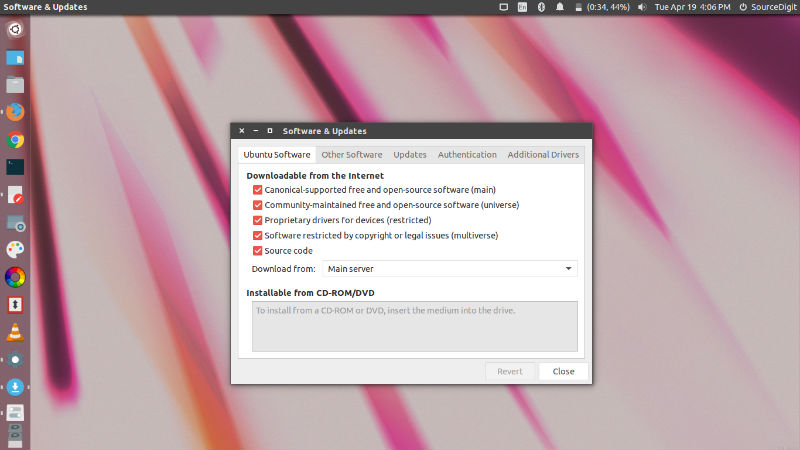Customize Ubuntu 16.10. Top 10 things to do after installing Ubuntu 16.10 Desktop. After fresh installation of Ubuntu 16.10, follow these tips to customize Ubuntu 16.10 Desktop.
Install updates for Ubuntu 16.10
Firstly, you must update Ubuntu 16.10 after a fresh install. Even ifyou have downloaded and installed all the third-party apps during the installation process. You can update the Ubuntu System via Terminal or using the Software Update too.
Install updates via terminal
Open terminal and run the following commands to update Ubuntu 16.10:
sudo atp-get update
sudo atp-get upgrade
Install updates via Software Update Tool
- Launch the ‘Software Update’ tool from Ubuntu Unity Dash
- Check for possible updates
- Click to install the update
Enable Ubuntu Extra Repositories
To enable Ubuntu Extra Repositories, open System Settings. Select Software and Updates utility tab and check all Ubuntu Software and Other Software (Canonical Partners) repositories. Close the Settings window and wait for a minute to reload the cache sources tree.

You must also enable to use Canonical Partners in Software Sources. Opne System Settings. Select Other Software tab and check the option named Canonical Partners and Canonical Partners (Source Code).
Install Graphics Drivers
Follow the steps given below to install the latest Linux graphics drivers:
- Launch the ‘Software & Updates’ tool from Ubuntu Unity Dash
- Click the ‘Additional Drivers’ tab
- Follow on-screen instruction to check and install the Linux graphics drivers.
Enable Edge/Horizontal Scrolling on Ubuntu 16.10
Since Ubuntu 13.10, two finger scroll is enabled by default and the normal edge scrolling doesn’t work automatically. You will have to enable Edge or Horizontal Scrolling on Ubuntu 16.10. To enable edge scrolling, go to System Settings > Mouse & Touchpad. Now uncheck the option of Two Finger Scroll.
You can also enable this setting by using UNITY Tweak Tool. Open UNITY Tweak Tool and under Scrolling options (System Tab-Unity Tweak Tool), select “Horizontal Scrolling.” It’s done. Now you should be able to scroll using the old method – horizontal scrolling.
Install restricted media codecs
By default, Ubuntu cannot play MP3, MP4 and other media files which needs few specific media codecs. To play all these files on Ubuntu 16.10, you will have to install restricted media codecs.
Click here to install restricted media codecs
You can also run the following command:
sudo apt install ubuntu-restricted-extras
sudo apt install libavcodec-extra
Another easiest way to install media codes is during the installation process. Simply check the “Enable Restricted Formats” option during installation.
Install Java on Ubuntu 16.10
Install Oracle Java 8 from the WebUpd8 Oracle Java PPA:
sudo add-apt-repository ppa:webupd8team/java
sudo apt update
sudo apt install oracle-java8-installer
If you need other versions of Java, run:
sudo apt install icedtea-8-plugin openjdk-8-jre
sudo apt install openjdk-8-jdk
Install Gnome and Unity Tweak Tool

To to customize Ubuntu 15.04 Desktop & Unity, install Ubuntu Tweak and Configuration Tools such as GNONME Tool and UNITY Tweak Tool. With Unity and Gnome tool you can customize your Ubuntu’s look and feel. It helps you to customize the appearance of Ubuntu desktop.
To install Unity and Gnome, type the following command (one after another):
sudo apt-get install unity-tweak-tool
sudo apt-get install gnome-tweak-tool
Once installed, open Unity Tweak Tool or GNOME Tool from Ubuntu Dash.
Enable minimise on click on Ubuntu 16.10
By default, Ubuntu 16.10 doesn’t have minimize on click enabled. So you cannot click on the same icon again to minimise the app. Luckily, this minimise on click function can be enabled by running the following command or using Unity Tweak Tool.

To enable minimise on click on Ubuntu 16.10, via terminal:
gsettings set org.compiz.unityshell:/org/compiz/profiles/unity/plugins/unityshell/ launcher-minimize-window true
To enable minimise on click on Ubuntu 16.10 via Unity Tweak Tool, install Unity Tweak Tool, open the app and go to Unity > Launcher > Minimise.
Move the Unity launcher
Until now the Unity launcher was hard-fixed on the left-hand side of the Ubuntu desktop. But with launch of Ubuntu 16.04, Ubuntu users can finally select the Unity launcher position – either bottom or left.
You can change the position of Unity launcher via terminal or Unity Tweak Tool. To change the position via terminal, run the command given below:
gsettings set com.canonical.Unity.Launcher launcher-position Bottom
To change the position via Unity Tweak Tool, open the app and go to Unity > Launcher > Position.
Always show application menu
Ubuntu users can easily select where app menus appear and for what time. Application menus can be forced to show always.
To enable application menus always show:
- Open Appearance from System Settings
- Select Behavior tab
- Go to Menus Visibility section
- Click Always displayed option
- Exit
To select the position of the application menu:
- Open Appearance from System Settings
- Select Behavior tab
- Go to section Show the Menus for a Window
- Click In the wind w’s title bar option
- Exit
Improve Battery Life & Reduce Laptop Overheating
Save battery power of Ubuntu laptops. Install TLP (Battery Power Management) in Linux Ubuntu and reduce battery overheating on Ubuntu laptops and increase battery life of Linux Ubuntu laptops. TLP is an advanced power management tool for Linux. It comes with a default configuration optimized for battery life. TLP applies various settings and battery tweaks that help to save laptop battery power and reduce overheating.
To uninstall the laptop mode-tools, open the Terminal and run the following command:
sudo apt-get remove laptop-mode-tools
Now run the following commands to install TLP by using its official PPA:
sudo add-apt-repository ppa:linrunner/tlp
sudo apt-get update
sudo apt-get install tlp tlp-rdw
sudo tlp start
There are also some optional packages you can install to improve battery life in Linux Ubuntu with TLP. You can install the optional packages via package management tools (Ubuntu Software Center, Synaptic, …) or terminal command. Run the following command to install the optional TLP packages:
sudo apt-get install tlp tlp-rdw
